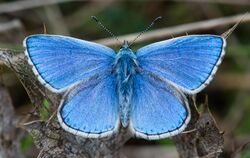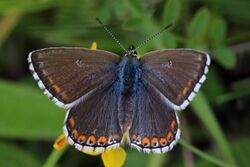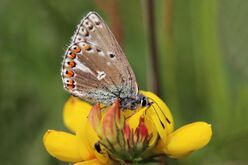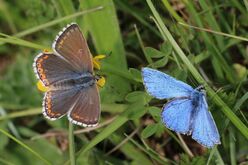Biology:Adonis blue
| Adonis blue | |
|---|---|

| |
| male, Aveyron, France | |

| |
| female, Buckinghamshire | |
| Scientific classification | |
| Domain: | Eukaryota |
| Kingdom: | Animalia |
| Phylum: | Arthropoda |
| Class: | Insecta |
| Order: | Lepidoptera |
| Family: | Lycaenidae |
| Genus: | Polyommatus |
| Species: | P. bellargus
|
| Binomial name | |
| Polyommatus bellargus (Rottemburg, 1775)
| |
| Synonyms | |
|
Papilio bellargus, Rottemburg, 1775 | |
The Adonis blue (Polyommatus bellargus) is a butterfly in the family Lycaenidae. It is found in the Palearctic ecozone (Western Europe, Central Europe, South Europe, South Russia, Iraq, Iran, Caucasus, Transcaucasus, Turkey).
It may be found in chalk downland, in warm sheltered spots, flying low over vegetation, seeking females that are rich chocolate brown in color. The male has brilliantly-colored wings that give it its name.
Description
The males are blue in color with a white border. Females are brown in colour becoming blue towards the body, with orange crescents towards the edges of the wings. Both males and females have pale brown undersides with black spots and orange crescents (1). The caterpillar reaches 1.6 centimetres in length, has a dark green body with dark spines (3), and yellow bands along the back and sides (1).
Range
Found across Europe; in Britain, the Adonis Blue is at the northern extreme of its range and has always been restricted to the warmer dry calcareous grasslands of southern England. It has suffered a huge decline in the past 200 years, and has been lost from Cambridgeshire, Essex, Suffolk, and the Chilterns. The strongholds are Dorset, Wiltshire, Sussex and the Isle of Wight. Over the whole of Britain there has been a decline of over 90% in numbers of this species since 1950.
Taxonomy
German entomologist S. A. von Rottemburg described the Adonis blue in 1775 as Papilio bellargus, noting it was very rare locally but came to his garden in June.[1]
Description
The male has the upper side wings a brilliant sky blue, with a fine black line round the edge and a white margin. The female is chocolate brown with a few blue scales near the base, and with orange spots, bordered by blue scales, around the edge of the hind wing. Look for the chequered fringes in both sexes. The underside is brownish grey with black and orange spots. The wingspan is about 3 cm (1.2 in).[2]
Distribution and habitat
The Adonis blue is found across Europe from Eastern and Central Europe across to southeast England and the Iberian Peninsula.
The preferred habitat of the Adonis blue is calcareous grasslands with hot and dry conditions. This is because the larva feeds on horseshoe vetch (Hippocrepis comosa) which is largely restricted to these habitats. This plant flourishes on sheep-grazed pastures and disappears after a few years when cattle graze. Sometimes human-created landforms provide refuges for the plant and the butterfly; an example of this is on Martin Down in Dorset, where horseshoe vetch only occurs on ancient earthworks with thin calcareous soils.[3]
Species decline (Great Britain)
The Adonis blue is at the most northerly edge of its range in Britain and has always been restricted to chalk grassland in the south. It has been declining over the last fifty years because its habitat has been disappearing through changing agricultural practices.[2] There are efforts from conservation organisations and local Biodiversity Action Plans to encourage the populations of chalk-grassland butterflies through managed grazing programs. The recent hot and dry weather associated with climate change seems to be beneficial for this species by making more habitats suitable. In 2006 it had returned to a site in the Cotswolds in Gloucestershire, where it had vanished 40 years previously.[4]
Other
- Winter is passed as a small caterpillar
- Habitat: Flowery hillsides on chalk and limestone
- Food plant: Horseshoe vetch
- Flight: May–September, in two broods
See also
- List of butterflies of Great Britain
References
- ↑ Rottemburg, S. A. von (1775). "Anmerkungen zu den Hufnagelischen Tabellen der Schmetterlinge. Erste Abtheilung." (in german). Der Naturforscher 6: 1–34 [25]. http://www.ub.uni-bielefeld.de/diglib/aufkl/naturforscher/naturforscher.htm.
- ↑ 2.0 2.1 "Adonis blue (Lysandra ellargus)". Wildscreen Arkive. http://www.arkive.org/adonis-blue/lysandra-bellargus/. Retrieved 7 March 2016.
- ↑ Dennis, Roger L.H. (2012). A Resource-Based Habitat View for Conservation: Butterflies in the British Landscape. John Wiley & Sons. p. 191. ISBN 978-1-4443-1526-4. https://books.google.com/books?id=b9VQy1oQ89wC&pg=PA191.
- ↑ "Rare blue butterfly returns home". BBC News UK. 7 August 2006. http://news.bbc.co.uk/2/hi/uk_news/england/gloucestershire/5251322.stm.
External links
| Wikimedia Commons has media related to Polyommatus bellargus. |
Wikidata ☰ Q1075581 entry







